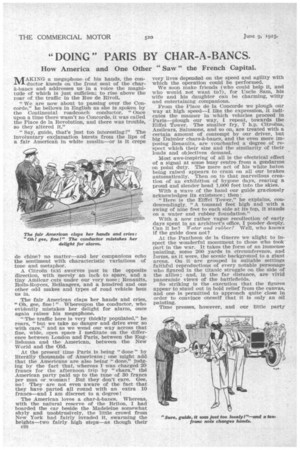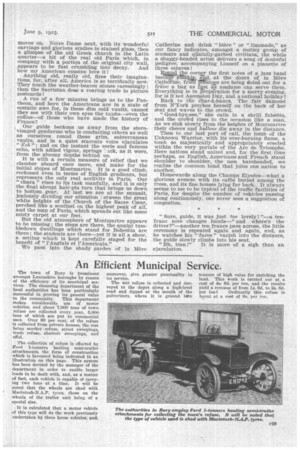"DOING" PARIS BY CHAR-A-BANCS.
Page 12

Page 13

If you've noticed an error in this article please click here to report it so we can fix it.
How America and One Other " Saw " the French Capital.
M.AKING a megaphone. of his hands, the con1-v-1--ductor kneels on the front seat of the chara-bancs and addresses us in a voice the magnitude of which is just sufficient to rise above the roar of the traffic in the Rue de Rivoli.
"We are now about to passing over the Concorde," he bellows in English as she is spoken by the Continental roadcoach• conductor. "Once upon a time there wasn't no Concorde, it was called the Place de in Revolution, and there was trouble, so they altered it."
" Say, guide, that's just too interesting!" The Involuntary exclamation bursts from the lips of a fair American in white muslin—or is it crepe de chine? no matter—and her companions echo the sentiment with characteristic variations of tone and metaphor.
A Citroen taxi swerves past in the opposite direction, with merely an inch to spare, and a tiny Amilcar cuts under our very nose; Renaults, Rolls-Royces, Bellangers, and a hundred and one other odd makes and types of road vehicle hem us in.
The fair American claps her hands and cries, "Oh, gee, fine ! " Whereupon the conductor, who evidently mistakes her delight for alarm, once again raises his megaphone.
"The traffic here is very thickly populated," he roars, "but we take no danger and drive ever so with care," and as we wend our way across that fine, wide, open space I meditate on the difference between London and Paris, between the Englishman and the American, between the New World and the Old.
At the present time Paris. is being " done " by literally thousands of Americans ; one might add that the Americans are also being "done," judging by the fact that, whereas I was charged 20 francs for the afternoon trip by " chara," the American party paid up to the tune of 30 francs per man or _woman I But they don't care. Gee, no! They are not even aware of the fact that they have parted all round with an extra 10 francs—and I am discreet to a degree!
The American loves a char-a-banes. Whereas. with the natural reserve of the Briton, I had boarded the ear beside the Madeleine somewhat shyly and unobtrusively, the little crowd from New York had fairly invaded it, swarming the heights—two fairly high steps—as though their 028 very lives depended on the speed and agility with which the operation could be performed.
We soon make friends (who could help it, and who would not want to?), for Uncle Sam, his wife and his daughter can be charming, witty and entertaining companions.
From the Place de la Concorde we plough our way at high speed—I like the expression, it indicates the manner in which vehicles proceed in Paris—plough our way, I repeat, towards the Eiffel Tower. The smaller fry, 7 h.p. Citroens, Amilcars, Salmsons, and so on, are treated with a certain amount of contempt by our driver, but big Daimler chars-a-banes, and the even more imposing Renaults, are vouchsafed a degree of respect which their size and the similarity of their loads and objectives demand.
Most awe-inspiring of all is the electrical effect of a signal at some busy centre. from a gendarme on point duty. The mere act of his white baton being raised appears to cram on all our brakes automatically. Then on to that marvellous creation of an exhibition of bygone days, rearing a proud and slender head 1,000 feet into the skies.
With a wave of the hand our guide graciously acknowledges its existence; then: "Here is the Eiffel Tower." he explains, condescendingly, "A tousand feet high and with a swing of nine feet to each side at its top, it stands on a water and rubber foundation."
With a now rather vague recollection of early days spent in an architect's office, I ponder deeply. Can it be? TVater and rubber? Well, who knows if the guide does not?
At the Pantheon de la Guerre we alight to inspect the wonderful monument to those who took part in the war. It takes the form of an immense painting, some 200 yards in circumference, and forms, as it were, the scenic background to a giant arena. On it are grouped in suitable settings faithful reproductions of every notable personage who figured in the titanic struggle on the side of the allies ; and, in the far distance, are vivid panoramic views of the battlefields.
So striking is the execution that the figures appear to stand out in bold relief from the canvas, and one is permitted to approach quite close in order to convince oneself that it is only an oil painting.
Time presses, however, and our little party moves on. Notre Dame next, with its wonderful carvings and glorious studies in stained glass, then a glimpse of the old Greek church in the Latin quarter—a bit of the real old Paris which, in company with a portion of the original city wall, appears to be fast crumbling into decay. And how my American cousins love it!
Anything old, really old, fires their imaginations, for, after all, America is so terrifically new. They touch the weather-beaten stones caressingly ; then the Sacristan does a roaring trade in picture postcards !
A run of a few minutes brings us to the Pantheon, and here the Americans are in a state of ecstatic awe for, in these dim cold vaults, cannot they see with their own eyes the tombs—even the coffins—of those who have made the history of France?
Our guide beckons us away from the sternvisaged gendarme who is conducting others as well as ourselves round these grim, subterranean vaults, and in a quiet staccato voice ejaculates " Ech": and on the instant the eerie and famous echo, with added vigour, springs ' ack, as it were, from the gloomy depths behind us. It is with a certain measure of relief that we clamber aboard once more, and make for the Initial slopes of Montmartre. It is a good climb, reckoned even in terms of English gradients, but represents the only real acclivity in Paris. Our " chara " rises to its task manfully, and it is only the final abrupt hair-pin turn that brings us down to bottom gear. At last we are at the summit, jealously dividing our attention 1. etween the great white heights of the Church of the Saere Cceur, perched like a sentinel on the highest peak of all, and the map of Paris, which spreads out like some misty carpet at our feet.
But the old atmosphere of Montmartre appears to be missing ; the steps are there, the quaint tumbledown dwellings which stand for Bohemia are there ; the students are there—yet it is all a show, a setting which is kept carefully staged for the benefit of " l'Anglals et l'Americain."
We pass into the shady garden of la Mere Catherine and drink " biere " or " limonade," as our fancy indicates, amongst a motley group of students and qiiaintly-garbed civilians, the while a shaggy-headed artist delivers a song of doubtful pedigree, accompanying himself on a pianette of three octaves!
R4,3.1. the corner the first notes of a jazz band becTEPTItlikk ad, at the doors of la Mere Catherine, frialleratoes are being doled out for a franc a bag as ft as inaclame can serve them. Everything is in preparation for a merry evening, for is it not A.ssension Day, and a national holiday? Back to the char-et,bancs. The fair damosel from N'York perches herself on the back of her Seat and waves to the crowd.
" Good-byteee," she calls in a shrill falsetto, and the crowd rises to the occasion like a man. As we sink slowly from the heights of Montmartre their cheers and hulloos die away in the distance.
Then to our last port of call, the tomb of the Unknown Warrior, with its ever-burning flame, a tomb so majestically and appropriately erected within the very portals of the Arc de Triomphe. Here nations stand united and, for the first time perhaps, as English, Americans and French stand shoulder to shoulder, the men bareheaded, we realize the common bond that joins one nation to another.
Homewards along the Champs Elysees—what glorious avenue with its cafes buried among the trees, and its fine houses lying far back. It always seems to me to be typical of the traffic facilities of Paris, for despite the number of vehicles passing along continuously, one never sees a suggestion of congestion.
" Sure, guide, it was just too lovely ! "—a tenfranc note changes hands—" and where's the driver ?"—another ten francs pass across, the little ceremony is repeated again and again, and, as he watches his " fares " vanish into the distance, the -guide slowly climbs into his seat. "Eli. hien!" It is more of a sigh than an ejaculation.






























